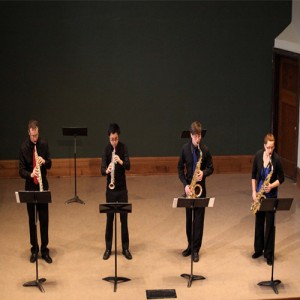Urban Influx and Attractions – Improvisation, theatre, rhythm and texture for saxophone quartet
Proteus Quartet will perform two virtuosic pieces, both diverse, by composers who have developed their own compositional language and are well known in the saxophone world : R.Lemay and D.Levaillant.

Biography
The Proteus Quartet was formed in Paris, France in November 2011 by four Canadian saxophonists while they were studying contemporary saxophone performance in French conservatories. In North America Proteus remains dedicated to commissioning and performing new works for saxophone quartet, having performed the North American premier of pieces by Denis Levaillant and Karol Beffa, they also performed the world premier of Urban Influx by Robert Lemay in 2014. Proteus Quartet has performed recitals in France, Canada, the USA including performances at the NASA Biennial Conference in Illinois, USA, as well well as the NASA Region 9 Conference in Saskatoon, Canada. They were invited in 2012 and 2013 to perform at the ‘Proms Summer Music Series’ hosted by the Third Ave. Centre in Saskatoon.
More information
Proteus Quartet recently premiered Urban Influx by Canadian composer Robert Lemay at the 2014 North American Saxophone Alliance Biennial Conference at the University of Illinois at Champagne-Urbana. This piece, which was commissioned by and written for Proteus, is Lemay’s first quartet written for a Canadian saxophone quartet. Robert Lemay is a well-known and prolific composer of saxophone music, having written virtuosic solo works, saxophone quartets, a saxophone ensemble piece, mixed chamber pieces as well as pedagogical works. This will be the European premier performance of Urban Influx at the Strasbourg congress. Urban Influx is inspired by a poem by Canadian poet Daniel Dugas from his book Au large des objets perdus. Like many of Lemay’s pieces, Urban Influx also utilizes many extended techniques and includes virtuosic writing for the saxophone, exploring a wide variety of colours, timbres and textures. His integrated use of slap-tongues, timbral-trills, multiphonics, growls, altissimo, resonance and quarter-tones creates a constantly evolving sound world. He often combines theatrics and improvisation as a formal and musical element building musical intensity and variety as the piece progresses. At times the quartet performs alternating passages moving across the ensemble to eventually arrive at unison passages. Extreme dynamic ranges along with pulsating sixteenth-note passages creates a driving pulse through much of the piece as it climbs towards the climax. Nearing the end of the piece we arrive at a section which is reminiscent of electroacoustic music, using the alitissimo range as well as extreme dynamics from pp to ff as someone is adjusting the equalization dials of a soundboard. After the final eruption, the piece ends with a calm final phrase.
Attractions by Denis Levaillant was premiered by le quatuor Xasax in 1996 and the North American premier was performed by Proteus Quartet in 2012. Having a diverse background as a musician, Levaillant first learned classical piano before pursuing a career as a professional jazz pianist and composer. He has published a well-known book on improvisation titled L’improvisation musicale (1980) combining improvisation based on classical oeuvres. He brings a diverse background to chamber music writing, with a large influence from performances in jazz combos. In Attractions, Levaillant brings together modern jazz with a more western style of composition. The piece is formally organized with a unison passage by all four members which returns with slight variations. This theme is separated by very expressive sections denoted as “like a single man”, “vociferous”, “feverish”, “recitative”, “very lyrical”, “polymelodic” utilizing a homogeneous, ‘living’ language. Each section is organized by varying textures which are all very distinct from one another. These characteristics are all combined into a virtuosic and idiomatic work which deserves more attention than it has garnered in the past.


 EN
EN FR
FR